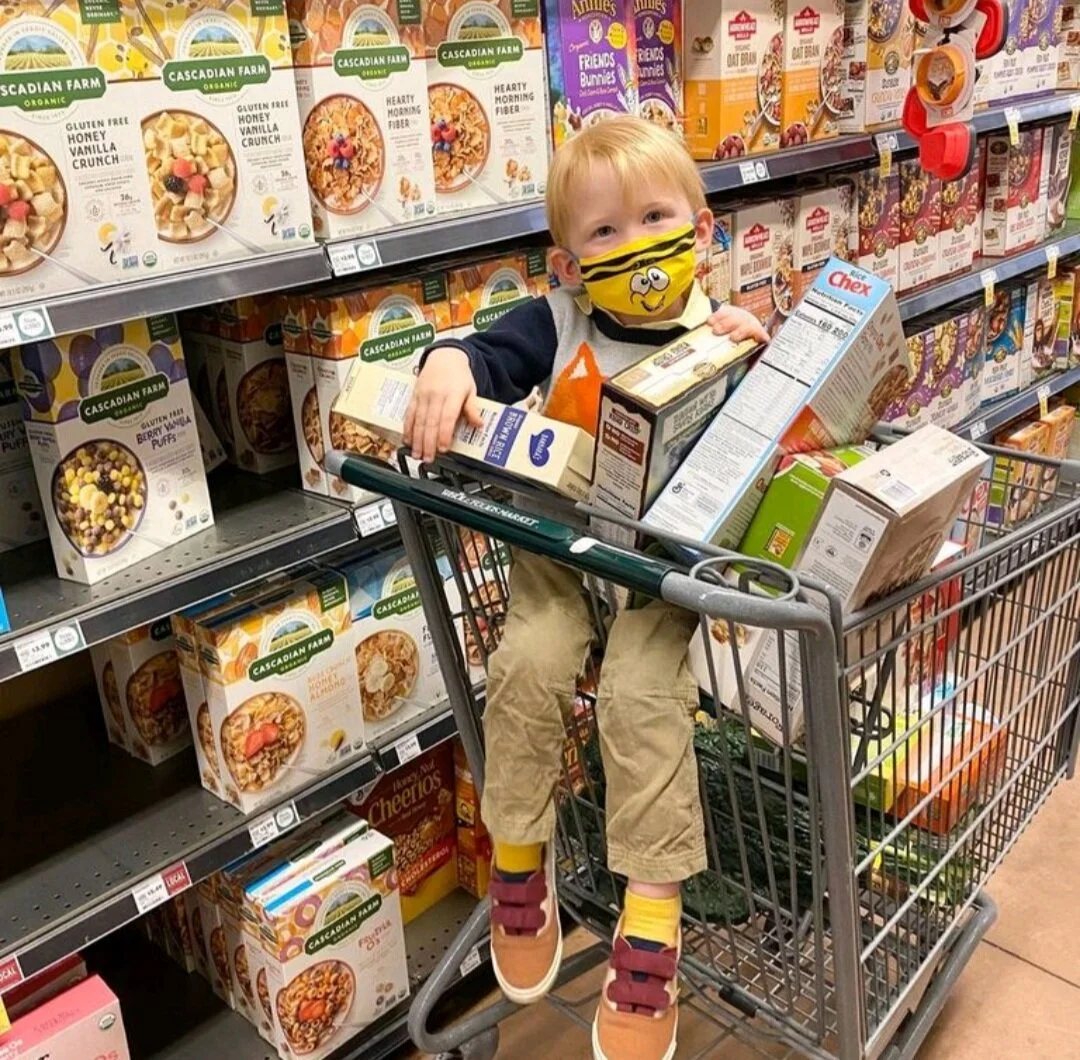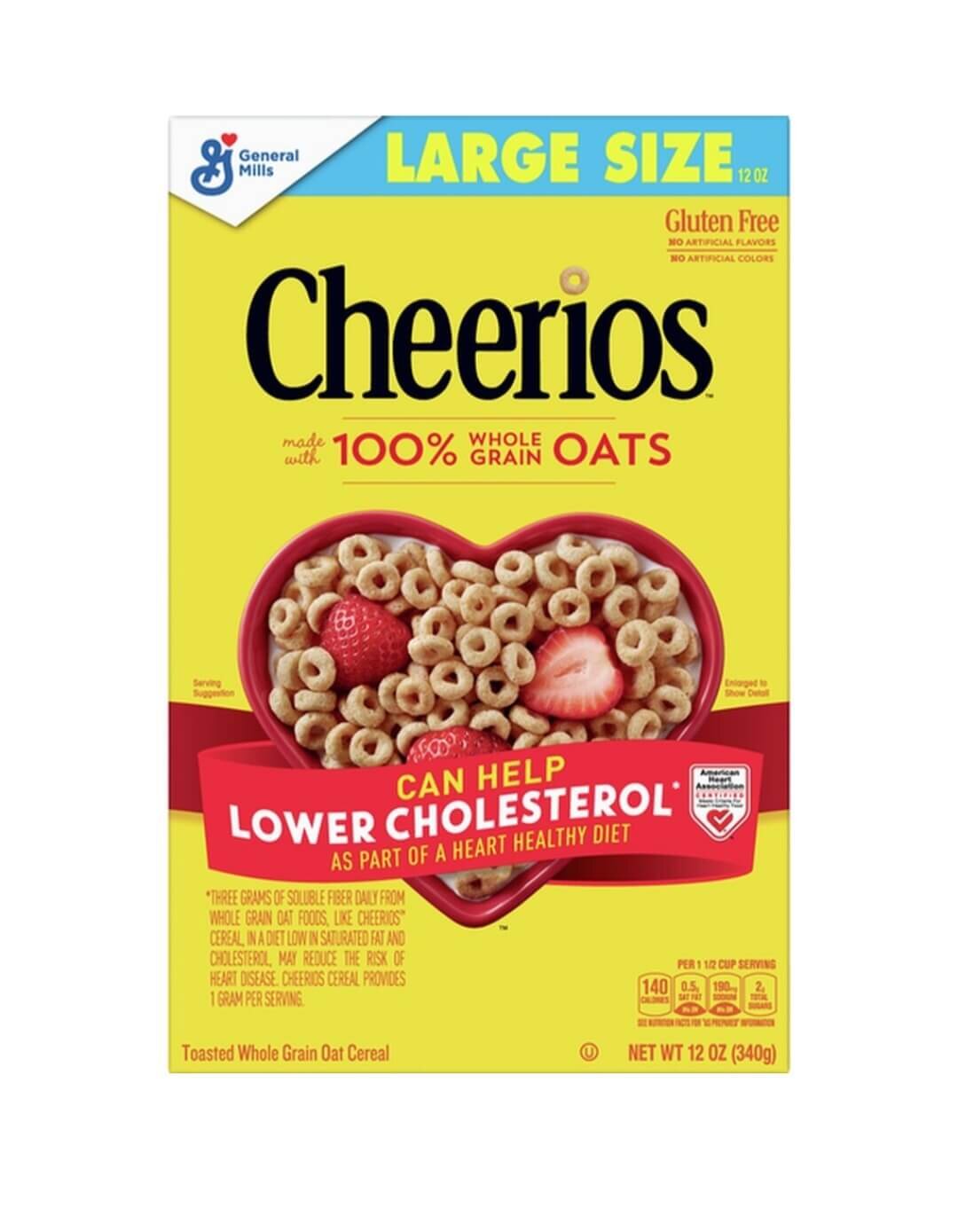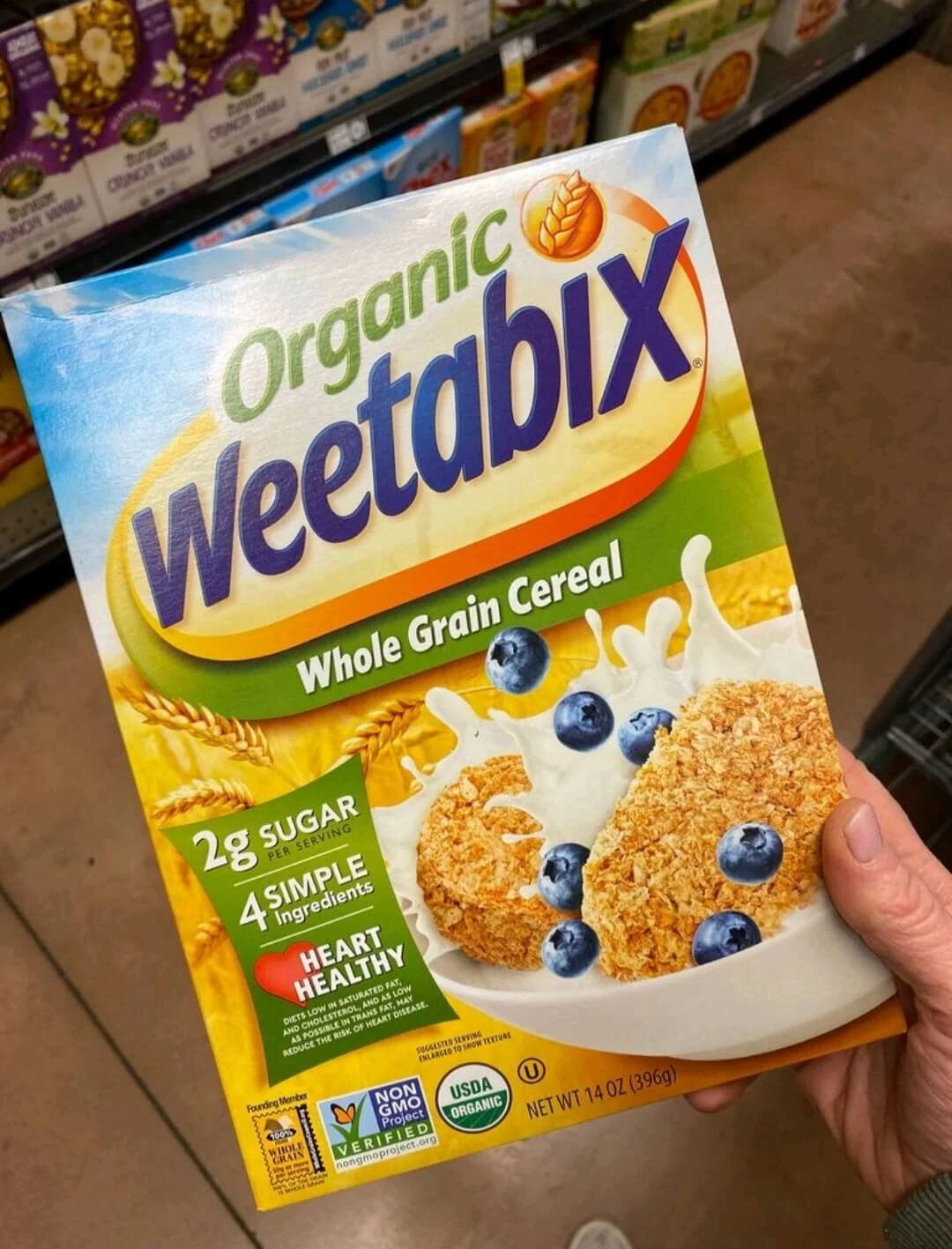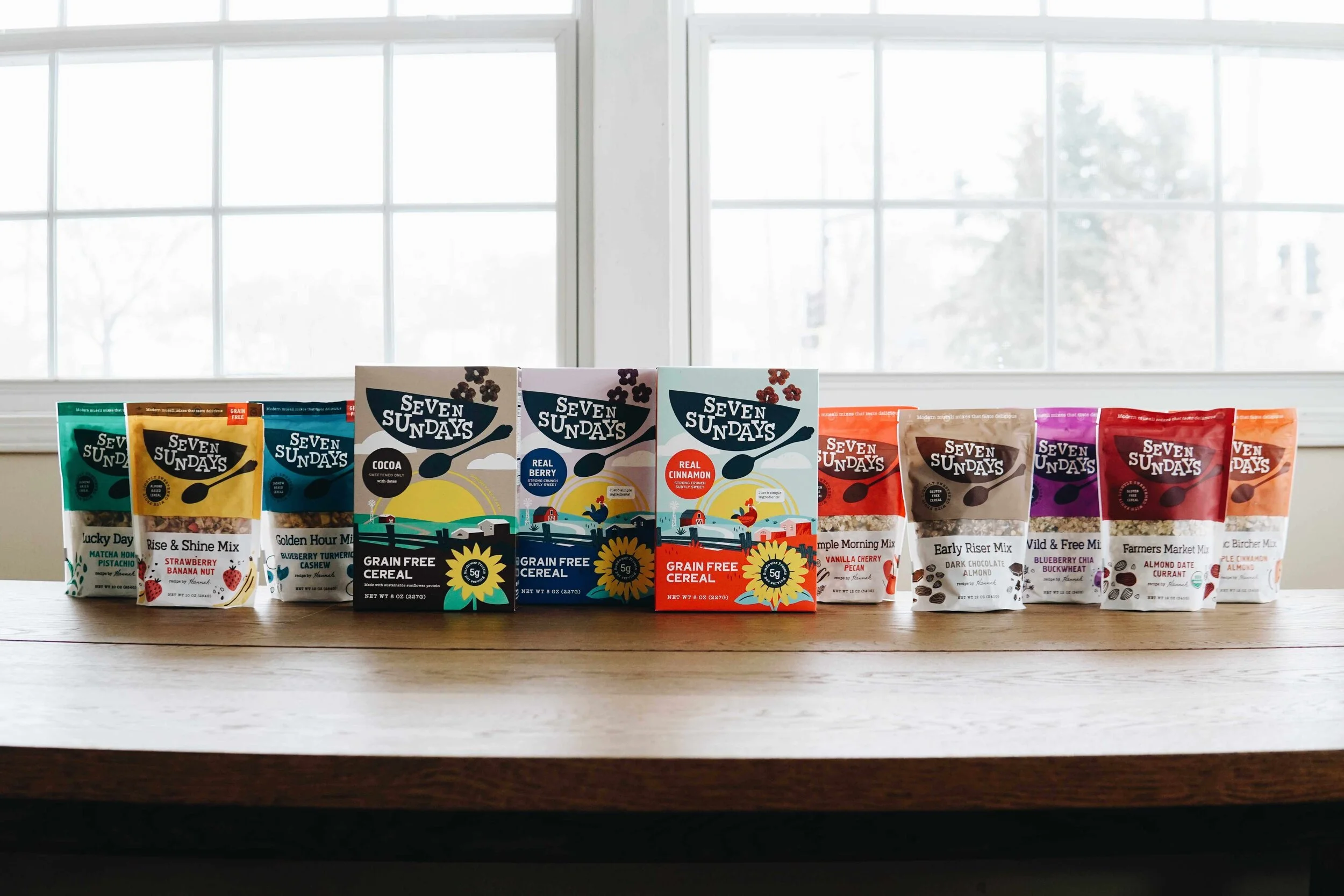How to Choose Cereals That Are OK for Kids to Eat
Disclaimer: This is not a sponsored post. I have not received any financial compensation from the brands or companies featured in the post for their inclusion. I am an affiliate for some of these brands and there are affiliate links included in this post.
How to Choose Cereals That Are OK for Kids to Eat
The cereal aisle can be a tricky place when you’re buying for kids. Cereals marketed directly to kids are almost certainly too high in sugar for everyday use. But there are some surprising finds in the cereal section and here are my label-reading tips & suggested low-sugar cereals for kids…
Why the Cereal Aisle is Sneaky
When you’re feeding kids, breakfast cereal can be a blessing and a curse.
I love breakfast cereal for its convenience and because if it’s iron-fortified I’m starting my kids off with a high iron food.
But cruise down the cereal aisle of any grocery store and the vast majority of what you see is not appropriate for children.
If you ask me - a mom of 7 and dietitian - the primary problem in the cereal aisle for kids starts with sugar and then is closely followed by salt.
...but as a cereal lover myself, I also know that any sugar free, salt-free cereal tends to taste like [insert your own expletive here].!
So while there are endless options in the cereal aisle, I boil it down to a few select cereals that I’ll buy for my family which might provide some ideas for you too.
Sugary Cereals as a Sometimes Food
My own mom is a dietitian and we had probably max 5 different cereals to choose from over the course of my childhood (...and we even lived to tell about it!! 😆)
On Father’s Day though, my mom always bought a big box of Sugar Smacks for my dad, which he then graciously shared with us. I remember it being a HUGE treat to have a super sugary cereal.
Other times my grandmother would treat us to Honey Nut Cheerios when we stayed at her house...a HUGE departure from the boring box of yellow Cheerios we ate most other days.
Point is: in our house at least, sugary foods like sugary cereals are a “sometimes food”.
For my family - if and when we eat sugar, it’s not going to be all the time and I definitely prefer not to start my kids’ day out by loading them up with refined sugars.
Sugar in cereals is a problem because there are too many other places in the kids’ diet where sugar is also hanging out.
The American Academy of Pediatrics reminds us that:
Sugar makes up about 17% of kids’ calories
We should limit sugar to no more than 25 g (6 teaspoons) per day for age 2+
No added sugars for children age 2 and under
If a serving of kids’ cereal has 12 grams of added sugar and most kids will eat about 2 servings worth in a sitting, that is 100% of their daily sugar allotment at breakfast.
...and of course that’s before they get plied with sugary snacks at every school event or sports function and birthday parties and treats and it goes on and on…
What it comes down to is: there just isn’t room for so much sugar at breakfast!
Why WIC Cereal Guidelines Work
There are no hard and fast rules about how many max grams of sugar per serving kids “should” have in cereal.
And rather than making up arbitrary guardrails for sugary cereals, I look to the WIC program.
The US Department of Agriculture’s Special Supplemental Nutrition Program for Women, Infants & Children (WIC) is a federally-funded program that provides income-eligible, pregnant, breastfeeding and non-breastfeeding women and children under the age of 5 with nutritious foods, breastfeeding support, education about healthy eating and referrals to other programs.
Personally and professionally, I am a huge advocate for and proponent of WIC. I have the good fortune to speak for many WIC state agency associations about the benefits of baby-led weaning...and while my work focuses on infant feeding, I also certainly promote their nutrition program for women and older children, especially when it comes to cereal.
WIC has some select cereals on their approved food package. These vary from state to state, but next time you’re at your grocery store, look for the WIC-approved stamp or sticker next to the product’s label.
What you realize is - WOW….there are NOT A LOT of cereals that meet WIC’s nutrition criteria.
But what there is - is good, and that’s a good place to start when selecting cereals for your kids.
How Does WIC Select Cereals?
Breakfast cereals provided by WIC have to have specific nutritional qualities: At least half of the total WIC approved cereals on a state agency’s list must:
Have whole grain as the primary ingredient list
Have no more than 6 grams of [added] sugars per 1 oz of cereal
Almost all WIC approved cereals contain 5 or more grams of fiber per serving and 50% or more of daily value for folic acid per serving.
Another important consideration is WIC approved cereals must contain a minimum of 28 mg iron per 100 g of dry cereal...which works out to about 45% of the US RDA for adults per every 1 ounce of dry cereal.
Although WIC guidelines and approved foods do vary from state to state, they are fairly consistent and generally a WIC-approved cereal is one you can feel very fine about serving to your kids.
Here is a list of the California WIC approved cereals.
If you want to get connected with your local WIC agency, to apply - contact your state or local agency to set up an appointment. You can call the toll-free number or visit your state’s website to find information about WIC in your area.
Can Babies Eat Cereal?
I get a lot of questions about whether or not babies can safely eat cereal.
As a specialist in baby-led weaning, I definitely promote the idea that babies can eat WAY more foods than we often give them credit for...but they can’t eat all foods.
Some limitations to cereals for babies include:
PINCER GRASP PROBLEMS - babies don’t develop their pincer grasp until a few months after starting solids. While older babies can easily pick up small foods like Cheerios, they are not an ideal first food because babies can’t pick them up to self-feed.
SMALL SIZE FOOD DOESN’T FLY - early on in BLW we don’t feed babies small pieces of food. Soft, cooked foods need to be cut into shapes about the size of an adult’s pinky finger and smaller pieces of food - like most cereals are - represent a choking hazard early on.
SUGAR - as mentioned above, AAP says no added sugars for children age 2 and under. Because you are hard-pressed to find no added sugar cereals, almost all cereals are ruled out for babies because of the added sugar situation.
SALT - even if you DO find a no or almost-no sugar cereal, it’s likely to be loaded with salt. While there are no hard and fast guidelines about sodium for babies, I recommend choosing products with less than 100 mg sodium per serving if you’re going to be serving it to your baby
Some cereals DO work for baby-led weaning, although I encourage parents to look for other alternatives to selecting carbohydrate or starchy foods.
In my 100 FIRST FOODS program there are 20 different starchy foods (including cereal) that babies can eat.
If you want to grab a copy of my 100 FIRST FOODS list, I give it away to everyone on my free weekly workshop called “BABY-LED WEANING FOR BEGINNERS: How to get your baby to try 100 foods before turning 1 without you having to spoon-feed purees or buy pouches!”
You can sign up for this week’s workshop times - and grab your free copy of my 100 FIRST FOODS list.
If you’re serving cereal to babies, a few I like are:
Weetabix - needs to be softened with milk or water or breastmilk or formula but the larger biscuit size makes it easy for babies to pick up and self-feed
Shredded wheat - if you can find the biscuit size, this works the same as Weetabix. Avoid the sugar-added versions & make sure cereal is soft before serving
Cheerios - yes cereals have added sodium but for older babies who do have their pincer grasp & are proficient in self-feeding they can handle smaller pieced cereals like Cheerios (just be sure you’re offering the yellow box plain Cheerios, not Honey Nuts or other sugar-added varieties)
Hot cereals like oatmeal or grits or porridges or any other whole grain you can offer on a pre-loaded spoon also work well for baby-led weaning.
Grab the 20 different starchy foods babies can eat from my 100 FIRST FOODS list when you sign up for my free BABY-LED WEANING FOR BEGINNERS workshop. Click here to sign up for this week’s workshop times.
Cereal Selections for Bigger Kids
Once you’re past the baby stage you’ll probably fall in love with the ease and convenience of breakfast cereals.
When selecting cereals, be sure to read your labels...keeping an eye out for:
ADDED SUGARS: 0 g added sugars for kids less than 2 and try to limit to no more than 6 g added sugars per serving for bigger kids a la WIC recommendations
IRON CONTENT: fortified breakfast cereals can be a great source of iron, read your labels and be sure to offer cereal with vitamin C packed fruit or vegetable serving to maximize iron absorption
ADDED SODIUM: this can be tricky for cereal as most lower sugar cereals have to have some sodium in them to be palatable. Use your best judgement and try to select cereals that have lower amounts of salt, I love <100 mg per serving but those can be hard to find
Below I’m sharing the info about a few other cereals I choose for my kiddos. I’m not super strict about sodium once we’re past the baby stage, but I do keep an eye on the added sugars line & that’s the primary selection criteria for these cereals:
Food for Life Baking Ezekiel 4:9 Sprouted Flourless Flake Cereal
I love Ezekiel bread for BLW because it’s one of the few low sodium breads you can find nationally (...if it’s not in your grocery’s bakery aisle it’s usually in the freezer section).
I don’t choose this cereal because it’s sprouted or it’s flourless (there’s nothing wrong with flour if you’re not allergic to wheat or have celiac disease!) ...but I do like that it has a variety of whole grains (sprouted wheat, barley, millet, lentils and spelt).
Serving size ¾ cup
Calories 210
Sodium 240 mg
Added sugars 3 g
Iron 2.1 mg (10% DV)
One Degree Organic Foods Sprouted Ancient Maize Flakes
You don’t have to choose organic foods to make good nutrition selections for your families. Some of the cereals shown here happen to be organic, but were not selected because of that.
The Sprouted Ancient Maize Flakes (basically fancy corn flakes) from One Degree Organics are a good bet for kids because of the simple ingredient list and minimal added sugar plus 1mg iron per serving:
Serving size: ¾ cup
Calories 180
Sodium 260 mg
Added sugars 4 g
Iron 1 mg (6% DV)
Forager Organic Grain-free Os Plain
A few years ago Cheerios got some flack for glyphosate in its cereals. I don’t buy into purging all Cheerios from my pantry, but my colleague and fellow dietitian Abbey Sharp from Abbey’s Kitchen did a really good summary on her take and she is much more educated about the issue than I am...you can read her writeup about glyphosate in Cheerios here.
I have no qualms about regular yellow box Cheerios for my kids, but if you’re looking for a “cleaner” option the Forager Organic Grain-free Os Plain are a good bet.
These are made with cassava root and navy beans (...again, nothing wrong with good old grains), but I like that there’s essentially no sodium and here are the stats:
Serving size 1 cup
Calories 110
Sodium 5 mg
Added sugars 2 mg
Iron 2 mg (10% DV)
Organic Weetabix Whole Grain Cereal
Weetabix doesn’t have to be organic, they just happened to have that variety at my local Whole Foods.
(…and if you’re looking for more Whole Foods BLW buys, check out my blog post called “10 BLW FOODS TO BUY FROM WHOLE FOODS”.)
I love Weetabix because it’s so different from typical American breakfast cereals, plus it’s just made with basically Whole Wheat plus a smidge of sugar and salt:
Serving size 3 biscuits
Calories 180
Sodium 190 mg
Added sugars 2 mg
Iron 3 mg (15% DV)
Arrowhead Mills Organic Spelt Flakes
Spelt is another type of wheat and whole grain and this cereal is impressive for low sugar, low salt content with a satisfying crunch!
Serving size 1 cup
Calories 100
Sodium 100 mg
Added sugars 2 g
Iron 6% DV
365 Bite Sized Wheat Squares
These are the Whole Foods brand 365 version of Shredded Wheat. Of all of the cereals featured in this post, this one has the most spectacular stats with no sugar and no salt and a natural source of iron.
The ingredient list contains only Whole Wheat with some Vitamin E to maintain freshness. Pretty basic & simple with lots of good fiber, iron and whole grains:
Serving size 1 ¼ cup
Calories 220
Sodium 5 mg
Added sugars 0 mg
Iron 1.7 mg (10% DV)
General Mills Rice Chex
Chex has always surprised me how much sodium it has (330 mg in a 1 ⅓ cup serving) but I put the Rice Chex on the list because of it’s low sugar content & it’s super high in iron (fortified):
Serving size 1 ⅓ cup
Calories 160
Sodium 330 mg
Added sugars 3 g
Iron 12.6 mg (70% DV)
Barbara’s Organic Brown Rice Crisps Cereal
I love Barbara’s brand of organic cereals, especially Puffins (the regular Puffins Original and Puffins Cinnamon each have only 6 g of added sugars and when they’re on sale I definitely buy them for my family.
But the Brown Rice Crisps Cereal is a fancier version of Rice Krispies and a good buy for kids.
There’s not much iron though - because, well, it’s just made out of rice and rice compared to whole grain alternatives has essentially no fiber:
Serving size 1 ⅓ cup
Calories 160
Sodium 125 mg
Added sugars 1 g
Iron 0.6 mg (4%)
Seven Sundays Grain Free Cereal
This is a new offering from Seven Sundays made with plant-based, Midwest grown, up-cycled sunflower protein.
What’s so cool about this cereal is it provides maximal nutrition value with minimal environmental impact. The crunch is satisfyingly strong and I love that it has no refined sugar, no artificial or natural flavors and it’s gluten free and grain free.
My kids LOVE the Real Cocoa Grain Free Sunflower Cereal. It’s the only chocolate cereal on this list and that’s because it doesn’t have added sugar. I recently did some work with Seven Sundays so they sent me all of their grain free cereals to try out and I was blown away by all 3 flavors, which in addition to chocolate include Real Cinnamon and Real Berry.
Here are the stats on the cocoa Seven Sundays sunflower cereal:
Serving size 1 cup
Calories 130
Sodium 0 mg
Added sugars 2 g
Iron 1 mg (6% DV)
Seven Sundays Mueslis
Seven Sundays also makes amazing muesli in addition to their new grain-free cereal. While certainly more popular in Europe than the US, American kids can still grow to love muesli.
I like to mix the Seven Sundays Mueslis with yogurt and fresh fruit for my kids for breakfast. All of the flavors have no added sodium and minimal added sugars.
Do Babies Need to Eat Rice Cereal?
Your baby does not need to eat iron-fortified rice cereal.
I’m a college and university Nutrition Professor and I’m still blown away by the textbooks in nutrition throughout the lifecycle that say babies “need” to eat iron-fortified rice cereal.
There’s nothing wrong with iron-fortified foods...it’s just that there are so many natural sources of iron out there that babies CAN and SHOULD be given the opportunity to learn how to eat, that why would we go buying a special baby food that is totally unnecessary?
While some of the above cereals are iron-fortified (and not appropriate for early eaters as described earlier in the post) whole grains are naturally a good source of iron.
And refined white carbohydrate foods should not become the base of baby’s weaning diet. Furthermore, parents often use iron-fortified rice cereal and spoon it into baby’s mouth.
Putting anything in a baby’s mouth - including a spoon - can be a choking hazard. We can offer babies pureed foods and still maintain the self-feeding philosophy of baby-led weaning by offering cereals on a pre-loaded spoon and allowing baby to self-feed.
For more information on how to do this, check out my BABY-LED WEANING MADE EASY podcast episode How to Pre-Load A BLW Spoon Self-Feeding Technique with Dawn Winkelmann, MS, CCC-SLP.






















































